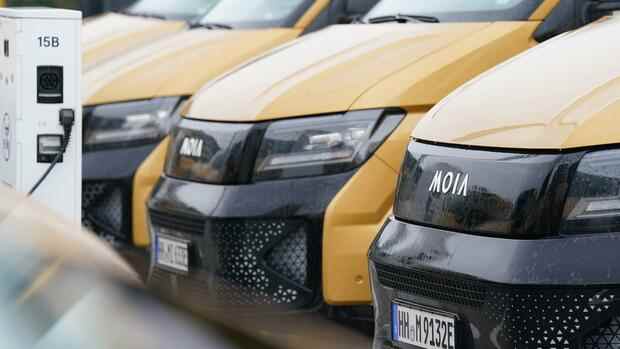The Volkswagen shuttle buses are designed to take the strain off the road.
(Photo: dpa)
Hamburg It’s teeming like an anthill: A simulation shows what Volkswagen’s shuttle experiment Moia could ideally look like. Dots that represent one of the minibuses move across the city map on the computer desk in all the larger streets. In the extreme scenario, there are 5000. The people of Hamburg would then cover three percent of all trips with Moia, and numerous people would get rid of their private cars.
Volkswagen has commissioned researchers from Karlsruhe KIT and the Technical University of Munich to provide scientific support for the shuttle system that was launched three years ago. You should provide evidence that the shared journeys that can be ordered via the app relieve the traffic system.
In the study presented on Wednesday, the researchers delivered: Especially if Moia were to use significantly more buses than today and at the same time lower the costs per trip thanks to autonomous driving, the system could replace car journeys and at the same time strengthen buses and trains. That could accelerate the turnaround in traffic.
However, for the ideal scenario, the researchers also assume that politics will noticeably slow down inner-city car traffic by introducing driving bans, speed limits and fewer driving bans.
Top jobs of the day
Find the best jobs now and
be notified by email.
“Traffic research shows that it is difficult to change people’s behavior,” warned KIT traffic researcher Martin Kagerbauer against too high expectations. The results for the current situation are sobering: with currently 250 shuttle buses, Moia only has a share of 0.1 percent in the traffic mix – even though the e-shuttles are already very present in the cityscape. After all, the researchers show that the shuttles do not cannibalize buses and trains.
Heterogeneous user base
From the survey of almost 12,000 users, they conclude that Moia users combine means of transport more often – for example, for a ride on the subway to the restaurant and back with a Moia. Most people use the shuttle, the price of which is between the train ticket and the taxi, only occasionally.
Demand is particularly high in the evenings. The user base does not correspond to the usual early discoverers of innovations such as e-scooters: With an average of 41 years, the user base is comparatively old. The controversial question of whether Moia is displacing taxis only touches on the study: So far, this has not been the case.
After Moia reduced the offer in the Corona period, the service should now be more present again, promised Moia spokesman Christoph Ziegenmeyer. In the coming months, up to 500 buses should gradually be on the road. So far, the city has not approved any more for the traffic test.
But VW is already thinking ahead: survey drives have been running since October in order to be able to drive autonomously in a small part of the city in the future. Finally, the study shows that a lower fare could lure more people into the shuttle vehicles.
The VW subsidiary is backed by politics for its future plans. This will “accompany the development of Moia in the coming months and years”, promised Hamburg’s Senator for Transport Anjes Tjarks in the foreword to the study. The Green politician would have to extend the approval for this.
For Volkswagen, Moia, which has previously been financed independently, has so far been a significant subsidy business, for which software and buses have been specially developed. It is intended to sound out the opportunities for new mobility services and autonomous offers.
In the future, the study could encourage cities to approve the concept, which was previously limited to Hamburg and Hanover and subsidize.
More: A great vision keeps Moia alive
